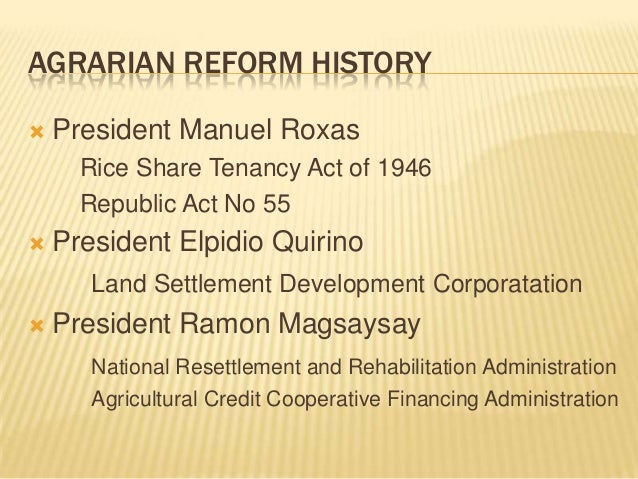Agricultural Programs Elpidio Quirino
In this, the or maternal is Rivera and the surname or paternal family name is Quirino. Main article: Incumbent President Elpidio Quirino won a full term as after the untimely death of in 1948. His running mate, won as. Despite factions created in the administration party, Quirino won a satisfactory vote from the public. It was the only time in Philippine history where the duly elected president, vice president and senators all came from the same party, the Liberal Party. The election was widely criticized as being corrupt, with violence and fraud taking place. Opponents of Quirino were beaten or murdered by his supporters or the police and the election continues to be seen as corrupt.
Elpidio Quirino was a native of Caoayan. Formed the Agricultural Cooperatives Financing Administration. Social Programs.
Second term (1949–1953). President Elpidio Quirino was inaugurated for his first full term as President of the Philippines on December 30, 1949 at the Independence Grandstand (now ), Manila. Baguio Conference In May 1950, upon the invitation of President Qurino, through the insistent suggestion of United Nations President, official representatives of India, Pakistan, Thailand, and Australia met in the city of for a regional conference sponsored by the. China and did not attend the conference because the latter did not contemplate the formation of a military union of the nations. On the other hand, Japan, Indonesia, China, and others were not invited because, at the time, they were not free and independent states. Due to the request of India and Indonesia, no political questions were taken up the conference. Instead, the delegates discussed economic and, most of all, cultural, problems confronting their respective countries.
Strangely enough however, the Baguio Conference ended with an official in which the nations attending the same expressed their united agreement in supporting the right to self-determination of all peoples the world over. This initial regional meet held much promise of a future alliance of these neighboring nations for common protection and aid. HukBaLaHap continued re-insurgence Quirino's administration faced a serious threat in the form of the communist movement.
Though the Huks originally had been an anti-Japanese guerrilla army in Luzon, communists steadily gained control over the leadership, and when Quirino's negotiation with Huk commander broke down in 1948, Taruc openly declared himself a Communist and called for the overthrow of the government. Peace campaign With the organization estimated to still have more than 40,000 duly registered members by March 1951, the government went on with its sustained campaign to cope with the worsening peace and order problem. The 1951 budget included the use of a residue fund for the land resettlement program in favor of the surrendered HUKS. The money helped maintain the Economic Development Corps (EDCOR), with its settlements of 6,500 hectares in Kapatagan and 25,000 hectares in Buldon. In each group taken to these places there was a nucleus of former Army personnel and their families, who became a stabilizing factor and ensured the success of the program. Indeed, less than ten percent of the Huks who settled down gave up this new lease in life offered them by the government. To promote the smooth restructuring of the, the military were made to undergo a reorganization.
Battalion combat teams of 1,000 men each were established. Each operated independently of the High Command, except for overall coordination in operational plans. A total of 26 Battalion Combat Teams were put up. New army units were also established, such was the first Unit, the, the Unit, and the Unit. These units all showed considerable ability. 1951 midterm election.
See also: As part of his Agrarian Reform agenda, President Quirino issued on October 23, 1950 Executive Order No. 355 which replaced the National Land Settlement Administration with Land Settlement Development Corporation (LASEDECO) which takes over the responsibilities of the Agricultural Machinery Equipment Corporation and the Rice and Corn Production Administration. Integrity Board To cope with the insistent clamor for government improvement, President Quirino created the Integrity Board to probe into reports of graft and corruption in high government places. Vice-President was most instrumental, through his courageous exposes, in securing such a decision from President Quirino. Foreign policies. Catholic Church, Conversion of St.
Paul, the Apostle (Vigan, Ilocos Sur) (November 19, 1890). Retrieved October 29, 2016. Bunye, Ignacio R. (24 May 2015). Retrieved 6 August 2017.
Vanzi, Sol Jose (1 November 2003). The Philippine Star. Retrieved 6 August 2017. ^ Molina, Antonio. The Philippines: Through the centuries. Manila: University of Sto.
Tomas Cooperative, 1961. Philippine Center for Investigative Journalism Retrieved June 14, 2017. Hedman, Eva-Lotta & Side, John Retrieved June 14, 2017. Taylor, RH Retrieved June 14, 2017. Retrieved 2009-08-09. Quoted from Zaide, Gregorio (1956). Philippine Political and Cultural History: the Philippines since British Invasion.

2 (1957 Revised ed.). Manila, Philippines: McCullough Printing Company. February 26, 2016. Retrieved February 26, 2016. Retrieved June 14, 2017. Philippine Primer Retrieved June 14, 2017.
Victoria Quirino-Gonzalez
Kobayakawa, Yohei Retrieved June 14, 2017 References. Zaide, Gregorio (1956).
Philippine Political and Cultural History: the Philippines since British Invasion (1957 Revised ed.). Manila, Philippines: McCullough Printing Company. Zaide, Gregorio F. Philippine History and Government. National Bookstore Printing Press. External links Wikimedia Commons has media related to. Has original works written by or about:.
Ramon Magsaysay
at. New York Times. Retrieved 2008-01-08.